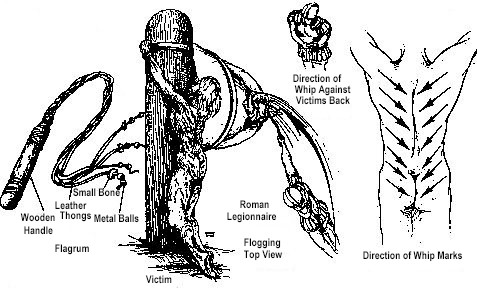 |
|
| Scourging.
Left, Short whip (flagrum) with lead balls and sheep
bones tied into leather thongs. Center left, Naked victim
tied to flogging post. Deep stripelike lacerations were
usually associated with considerable blood loss. Center
right, View from above, showing position of lictors.
Right, inferomedial direction of wounds.
|
|
Health of Jesus
The rigors of Jesus' ministry
(that is, traveling by foot throughout Palestine) would
have precluded any major physical illness or a weak
general constitution. Accordingly, it is reasonable to
assume that Jesus was in good physical condition before
his walk to Gethsemane. However, during the 12 hours
between 9 PM Thursday and 9 AM Friday, he had suffered
great emotional stress (as evidenced by hematidrosis),
abandonment by his closest friends (the disciples), and a
physical beating (after the first Jewish trial). Also, in
the setting of a traumatic and sleepless night, had been
forced to walk more than 2.5 miles (4.0 km) to and from
the sites of the various
trials. These physical and emotional factors may have
rendered Jesus particularly vulnerable to the adverse
hemodynamic effects of the scourging.
SCOURGING Flogging was a legal preliminary
to every Roman execution, (28) and only women and Roman
senators or soldiers (except in cases of desertion) were
exempt. (11) The usual instrument was a short whip
(flagrum or flagellum) with several single or braided
leather thongs of variable lengths, in |
which small iron
balls or sharp pieces of sheep bones were tied at
intervals. Occasionally, staves also were used. (8,12)
For scourging, the man was stripped of his clothing, and
his hands were tied to an upright post. (11) The back,
buttocks, and legs were flogged either by two soldiers
(lictors) or by one who alternated positions. (5,7,11,28)
The severity of the scourging depended on the disposition
of the lictors and was intended to weaken the victim to a
state just short of collapse or death. (8) After the
scourging, the soldiers often taunted their victim. (11)
Medical Aspects of Scourging As the Roman soldiers repeatedly struck the victim's back with full force, the iron balls would cause deep contusions, and the leather thongs and sheep bones would cut into the skin and subcutaneous tissues. (7) Then, as the flogging continued, the lacerations would tear into the underlying skeletal muscles and produce quivering ribbons of bleeding flesh. (27,25) Pain and blood loss generally set the stage for circulatory shock. (12) The extent of blood loss may well have determined how long the victim would survive on the cross. (3) |
| Back | Next |